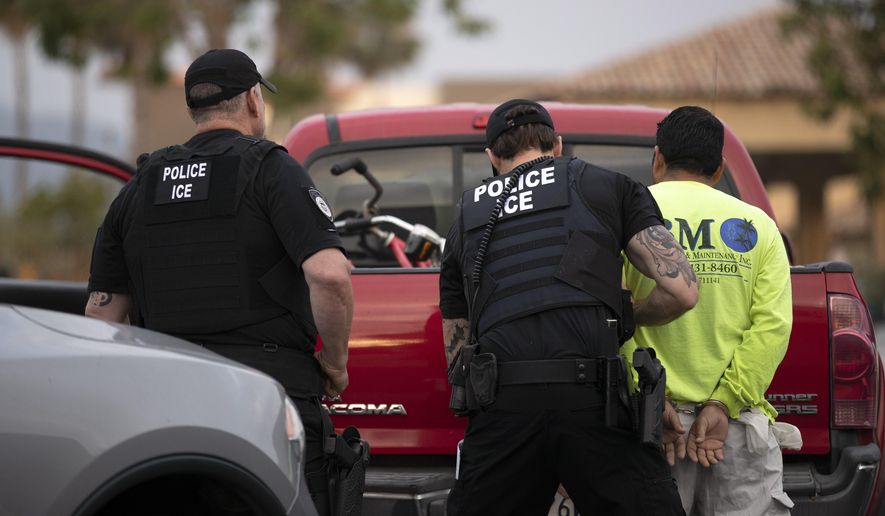ICE issued new guidance Thursday to grant deportation officers leeway to arrest and deport illegal immigrants, moving to replace rules issued on the Biden administration’s first day that led to some embarrassing black eyes.
High-level felons, national security risks and new border jumpers are high priority and are presumed to be deportation targets. One official called them “the cases that the public cares most about.” Most other illegal immigrants are not presumptive targets, U.S. Immigration and Customs Enforcement said in the new rules.
Drunken drivers, some domestic assault offenders, identity theft convicts and other felons whose crimes don’t rise to the level of “aggravated” are not automatic priorities.
Officers can still try to deport them but must make written requests and get supervisors’ approval beforehand. Cases will be judged on mitigating factors such as family ties, said Homeland Security Department officials.
“It’s just a question of us reallocating resources to cases that truly matter,” a Homeland Security official told reporters.
ICE officers will have to alert communities before attempting to make “at-large” arrests, Tae Johnson, acting director at U.S. Immigration and Customs Enforcement, wrote in the new rules.
Homeland Security officials wouldn’t say how many deportations they expect the new guidance to cancel.
The guidance binds ICE officers and agents as the new administration tries to curtail the deportation machinery that ousted record numbers over the past decade, dating back to the Obama administration.
It replaces early rules written on the first day of President Biden’s term.
Those rules led to some embarrassing cases. In Texas, deportation officers were poised to take custody of convicted sex offenders in cases involving juveniles, but those detainers were about to be canceled by supervisors.
The detainers were restored after Texas officials intervened.
ICE also postponed an entire operation aimed at arresting illegal immigrant sex offenders in the community.
It’s not clear how much the new rules will help clear up those kinds of snafus.
In practice, forcing officers to write out justification for approval means many migrants, including those who will be deemed deportation targets, will still go free, officers told The Washington Times.
That’s because some jurisdictions give notice only minutes or hours before they plan to release an illegal immigrant from prison or jail, before the approval process can be completed, the deportation officers said.
The new rules also severely restrict “collateral” arrests. If ICE goes after a target migrant but encounters other illegal immigrants along the way, those other migrants will be left free unless they are on the priority list, Mr. Johnson wrote.
“The approval to carry out an enforcement action against a particular noncitizen will not authorize enforcement actions against other noncitizens encountered during an operation if those noncitizens fall outside the presumption criteria,” Mr. Johnson wrote in his guidance.
Under the new rules, officers are allowed to “presume” cases are priorities if they fall into one of three categories: national security risks, aggravated felons and criminally active gang members, and new illegal immigrants, defined as those who became unlawfully present after Oct. 31.
Those who don’t make the high-priority list could still face deportation if a supervisor gives prior approval for the arrests.
An illegal immigrant whose criminal record is older, has health problems, has burrowed into a community or has managed to start a family in the U.S. will get preferential treatment, officials said.
Officials said they are trusting officers to make the right calls, but a list of arrests will go to the ICE director and homeland security secretary every week so they can bring down the hammer if needed.
Immigrant rights groups called the new guidance a “step backward” for the Biden team.
“We expect better from the Biden administration,” said Naureen Shah, policy counsel at the American Civil Liberties Union. She said the new guidance “will lead to disproportionate deportations of Black and brown immigrants.”
Most immigration enforcement is a civil affair, not criminal.
Those in the U.S. without permission are taken into custody and sent through the immigration court system. The ultimate punishment is removal from the country. Only a small fraction of cases, usually involving repeat illegal border crossings, are prosecuted criminally.
In 2020, ICE removed about 185,000 migrants, down dramatically from the year before thanks in large part to the COVID-19 pandemic.
The record for deportations was set in 2012 under President Obama, with nearly 420,000.
Horrified by that level of success, the Obama administration moved to limit the number by issuing its own priority lists to shape deportation targets.
When the Trump administration took over, officials said, deportation officers were “unshackled.” Those with criminal records were still priorities, but anyone caught in the country illegally could be taken into custody.
The Biden administration guidance restored the shackles, officers said.
Homeland Security, heeding Mr. Biden’s campaign promise, also announced a 100-day pause on almost all deportations. A federal court put that policy on hold, but the ICE guidance has still taken a large bite out of immigration enforcement activity.
The new priorities are considered “interim guidance.” They are supposed to be replaced in about three months with rules coming from the top of the Homeland Security Department. Those rules are expected to bind all immigration agencies, not just ICE.
• Stephen Dinan can be reached at sdinan@washingtontimes.com.




Please read our comment policy before commenting.